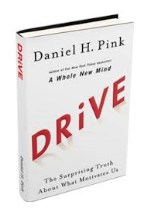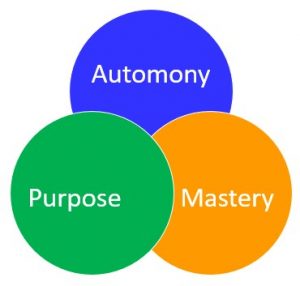Motivating People through Internal Incentives
Motivating People with External Rewards
Many people believe that the best way to motivate others is with external rewards like money, certificate of accomplishment, or a trophy. This is the old “carrot-and-stick approach.” Those motivation theories may have worked well in the past, however, they are not conducive with motivating people in today’s business world.
Studies have shown, the use of rewards and punishments to control employees’ performance and production is ineffective in managing people’s performance.
Extrinsic motivators like money and other external rewards worked well for twentieth century businesses because of the manual work and simple solutions. However, in today’s business world, many workers do not do the manual work with simple solutions. They do much more complicated tasks with no simple answer. Most business tasks today involve cognitive skills, decision-making, problem-solving, and/or creativity. Studies have shown external rewards can actually lead to decreased performance. People get so focused on getting the reward, they are not focused on the activity. They fixate on “the faster I get it done, the quicker I get my reward.”
External rewards often have negative consequences such as:
- Foster short-term thinking
- Hasten decision making
- Promote quick solutions
- Encourage cheating
- Support shortcuts and unethical behavior
- Diminish performance
- Diminish creativity
- Surpass intrinsic motivation
- Focus on reward and not results
Dan Pink’s Drive – Motivating People through Internal Incentives
In his book, Drive: The Surprising Truth About What Motivates Us, Daniel Pink contends that true human motivation is mainly intrinsic. He believes people’s behavior is driven by internal incentives, and not external rewards. He argues against old models of motivation driven by fear, money, and rewards.
Motivating people in the Today’s Business World
Pink believes business’s need to foster intrinsic behavior. This behavior concerns itself less with the external rewards that an activity can bring and more with the inherent satisfaction of the activity itself.
Pink discusses the theory of self-determination. This theory purports that we have three innate psychological needs; competence, autonomy and relatedness. When those needs are satisfied, we are motivated, productive, and happy. When they are impeded, our motivation, productivity, and happiness drop. Therefore, organizations should focus their efforts on creating environments that allow these innate psychological needs to flourish.
Key to Peak Performance
The key to peak performance is the deeply human need to direct our own lives, to learn and create new things, and to do better by ourselves and our world.
Motivating People through Internal Incentives
In his book, Pink examines the three elements necessary to motivate people who work beyond basic tasks. These three elements are:
- Autonomy – the desire to direct our own lives.
- Mastery — the desire to continually improve our skills and become better at something that matters.
- Purpose — the desire to do something that has meaning and is important. Basically, to do what we do in the service of something larger than ourselves. People intrinsically want to do things that matter and make a difference.
Autonomy
Autonomy is the desire to direct our own lives. A sense of autonomy has a positive effect on individual performance and attitude.
Management improves compliance, but decreases autonomy for most workers. If organizations want employees to be more engaged in what they are doing then allowing people autonomy will go a long way to achieving that.
Many extremely successful companies around the world such as Google have shown that employee motivation and performance increases when people have autonomy. Google lets people allocate 20% of their time to personal projects. This freedom to spend time doing their own thing leads to many more innovative ideas and solutions. About half of Google’s new products like Gmail have come from these personal projects.
In his book, Pink provides some examples of what he means by autonomy, summarizing them into four main aspects:
Task – What they do
Time – When they do it
Team – Who they do it with
Technique – How they do it
Mastery
Pink describes mastery as the desire to continually improve at something that matters. He believes that humans want to get better at stuff. He believes they get satisfaction from personal achievement and self-development.
Allowing employees to experience a sense of personal achievement at work contributes to their inner drive. However, on the contrary, a lack of opportunity at work for personal and professional development is likely to make employees bored and demotivated.
In his book, Pink explains that Mastery begins with “flow.” This is when our challenges are matched with our abilities and we are so in the moment we can lose track of time. Although flow is essential to mastery, it does not guarantee mastery. Flow happens in a moment, while mastery unfolds over several months or years.
Purpose
Pink describes purpose as the desire to do things in service of something larger than ourselves. Pink believes that people intrinsically want to do things that matter. They want to feel that they belong to something greater and more permanent than themselves.
Most people spend more than half of their awake hours at work. They want that time to matters in the big scheme of things. A big part of that is ensuring that their organization’s mission and goals are aligned with their personal and professional goals. Employees need to know how their work and role fits into what the organization is about.


